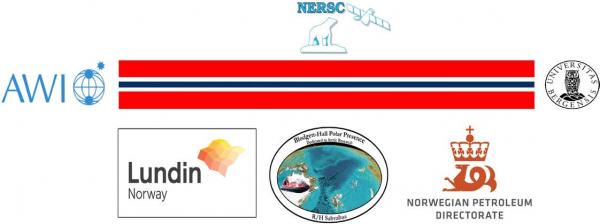
(30 March - 13 April 2015)
Ice drift
The FRAM-2014/15 ice camp has experienced two weeks of very slow and irregular drift, at times opposite of the wind direction. A net drift of only 6.35 nautical miles (12 km) was towards the Fram Strait. Surface air pressure gradients in our area have been weak throughout the period. High surface air pressure over the Beaufort Sea persisted up until Monday 6 April and later moved slowly towards Siberia. Weak incursions of a low pressure trough between Svalbard and Franz Josef Land towards the Canadian Arctic Islands occurred on Friday 3 April and 6th through 9th April. The wind speed at our location during these incursions increased from about 5 knots to 10-18 knots and directions were variable. The slow ice drift during the past month (72 km) probably reflects the stable weather conditions dominated by large high surface air pressure cells and few incursions of low pressure centers from the North Atlantic.
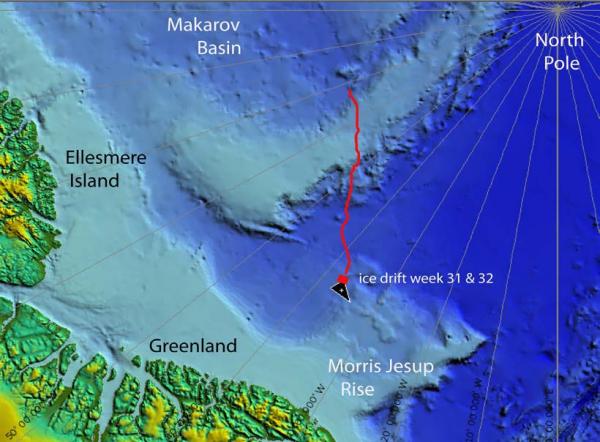
Fig. 1. The drift of FRAM-2014/15 during week 31 and 32; 30 March - 12 April 2015 (heavy red line). Thin red line indicates start of 570 km long seismic transect from the Makarov Basin to the Morris Jesup Rise.
Sea ice dynamics
Having escaped the ice pressure event that erased our camp area, and been parked for four days at the new location, we saw a new crack opened about 35 meter in front of the hovercraft and widened to about 20 meters (Fig. 2). No ice activity has occurred since then. Today, 14 days later, the ice thickness on the refrozen lead is 44 cm.
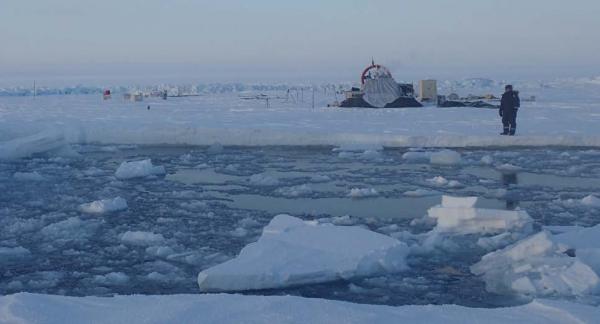
Fig. 2 A new lead opened 35 meter in front of the hovercraft on 31 March and froze over. The pressure ridge which consumed the earlier camp site is seen in the background.
Camp life
Air temperatures during the past two weeks has been nearly constant (- 30° C to - 35° C ) except Saturday 4 April ((- 28° C),Tuesday 7 April (- 25° C) and Sunday 12 April (- 19° C). The weather has been gorgeous with the sun shining around the clock except for two days of white-out. However, the ice drift, our science activity and life in general have been on hold.
In the early hours of Monday 30 April, the hovercraft engine stopped while charging the batteries. It was clearly a fuel issue and we located the problem to be air coming into the fuel line through a leaky primer pump. The pump was beyond repair, but the problem was circumvented by a ball valve from our "nice-to-have box". To get the final air out of the system and the engine to fire on all cylinders require considerable effort by the electric starter. On the final stretch, this exceeded our battery capacity. As a result, the hovercraft became immobile, the batteries were flat and no option available to get them charged - we needed a generator. What was left of battery capacity had to be reserved for communication and all systems requiring power were turned off, even the navigation PC. From now on, navigation was by hand held GPS.
Two weeks earlier, we had inquired about the possibility of a Norwegian air drop of generators to the ice camp, and now Easter time was here. We had also contacted the Danish Arctic Command in Greenland and got a very positive response, but the earliest flight opportunity available was 23 April.
The Russian activity to establish the annual Barneo ice camp near the North Pole was ramping up and we approached the Expeditionary Centre of the Russian Geographical Society, to explore the possibility of assistance to obtain generators and cost share delivery by an air drop. Generators were acquired in Murmansk, but a series of unfortunate delays implied the tough challenge of transport by helicopter from Barneo to FRAM-2014/15, a distance of 300 nautical miles or halfway from Svalbard to the North Pole. The air drop by the 333 Sq. of the Norwegian Air Force finally came through on Friday 10 April under optimum weather conditions. The P-3 Orion with chief pilot Johan Hætta and his crew delivered four parachutes and jettisoned six cartons and a surprise package in the same drop zone as used on 23 December 2014 in total darkness. The result is shown in Fig. 3. Use of parachutes from P-3 Orion is not a regular activity and was of special interest to the parties involved. The operation went like clockwork and all items were received in good order. This included generators (2), a new winch, diesel primer pumps, antifreeze, 10 kilos of oatmeal, onions, oranges, the favorite cake and newspapers etc. (Fig. 4). The P-3 Orion made a few passes for photo documentation of the camp environment and returned to base. Two hours later, the generator was running and our activity could return normal. Most importantly, we have regained our mobility and preparedness to safely face any unexpected new ice activity.
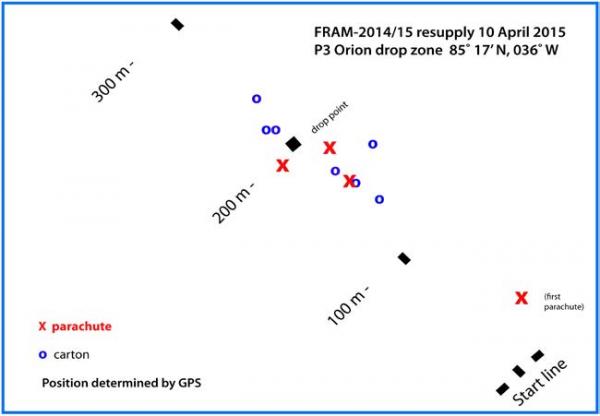
Fig. 3. Drop zone (upper panel) and the received cargo assembled in the camp (lower panel)
Safety
Science in a safe way is our priority. Many components contribute to a safe operation in the sea ice environment. To us the ability to communicate with the outside world is by far the most important. For this reason, we have three separate sets of Iridium telephones and HF capability via amateur radio. If the need arises, the means and level of support have to be defined from the ice and not from the shore, otherwise the response will not be rooted in the reality.
To us, the situation during the last two weeks is considered an unfortunate circumstance which highlighted the recognized need for resupply. Lack of mobility is a serious concern as new ice activity could in no time have taken the situation to a new level. The risk would be to the immobile hovercraft and supplies, but remote from presenting any direct risk to human life. In the worst case, as pointed out in the previous report, we have the resources, supplies and communication to live comfortably on the ice during the months needed for the ride down to the Fram Strait.
Science
Underway continuous measurements:
Bathymetry and sub-bottom profiling:
- one autonomous echo sounder buoys reporting to shore via Iridium
Oceanography:
- two Aanderaa current meters at 800 and 2.000 (recovered) meter depth.
Atmosphere:
- measurement of incoming and outgoing radiation from the ice surface
- surface infrared skin temperature
- sun time
- Aanderaa weather station
Station work
None.
Three weeks have passed with no seismic reflection measurements, but the camp has only moved less than 30 km in the direction of the Fram Strait during that time. The work space and the hydro hole are finished at the new site and we are ready to continue the geophysical and geological data collection effort. We would however, like to see a more continuous and direct drift track before we start firing the air gun again. Slow ice drift is associated with a complicated trajectory tracing out nested swirls of a few hundred meter radius with essentially nil net southeast motion.
Sea ice activity presents a certain amount of risk to all long term instrument deployments. We have earlier (late November) lost the acoustic Doppler current meter (ADCP) and two weeks ago the thermistor string to ice activity. To be safe, we decided to recover the current meter suspended for 7 months below the ice, mostly at 2.000 meter depth. This job was done in three steps where we first man hauled 1 km pr. day. The last task was making a hole in the 1.5 meter thick ice and successfully recover the instrument (Fig. 4). The second current meter is only a few meters from a pressure ridge and the Kevlar line has been deflected by underthrusted ice. The recovery job will be a major effort and is put off until it gets warmer.
The disruption incurred by the ice activity and subsequent two week power problem caused a four day loss of data for the radiation flux instruments and the weather station.
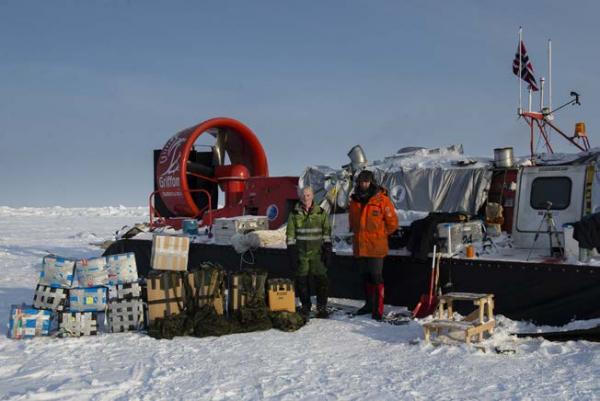
Fig. 4 Recovering the current meter by hauling up the 2 km of Kevlar line (upper left), making a hole in the ice (lower left) and the final recovery (right) in pleasant - 30° C.
Acknowledgement
We thank the 333 Squadron of the Norwegian Air Force, the crew of the P-3 Orion and other support personnel for once again providing much needed supplies to a remote location. The positive attitude and the effort of our Russian colleagues at Barneo and Pole Position Logistics, to provide assistance, are much appreciated.
There has been no sign of animal life in our neighborhood during the two weeks.
Despite the cold and flat batteries, life in the High Arctic is treating us well.
Yngve Kristoffersen & Audun Tholfsen
Daily reports
Monday 30 March.
Position: 85° 19.2' N, 37° 15' W, temperature - 32° C, air pressure 1025 hPa, wind 4 knots from the ENE. Ice drift 0.1 knot to the SE. The engine stopped just after midnight while charging batteries. Got it going by bleeding fuel filters. This happened several times in a row. Started searching for the fault. Unrestricted flow in the fuel line, but diesel is dripping from the primer pump. When the engine is running, air is sucked into system via this route. Found a ball valve in my junk box with the right threads and put the valve between the block and the primer pump. Purged air out of the system using a separate 12 volt pump and closed the valve. Had the engine running on a couple of cylinders, but on the last stretch, the battery capacity was exhausted. We had from now on, no possibility to charge our batteries. Closed down all systems, also the navigation PC - will obtain position information from handheld GPS for the time being. Power to internet switched on as needed. The 24 volt hot water circulation pump was put on a separate 12 volt battery. Informed NERSC and John K. Hall and requested a reminder to FOH to consider an air drop of generators. Also sent an e-mail to the Danish Arctic Command inquiring about flight opportunities.
Tuesday 31 March.
Position: 85° 18.8' N, 37° 13' W. All instruments turned off to save power. Moved the weather station and the radiation flux instruments at the new camp site. The fan on the radiation flux sensor will not have power until our generator problem is sorted out. Audun marked N-direction on the ice floe and measured the azimuth of the weather station to be = 354° . Audun also prepared recovery of the current meter at 2.000 meter depth and pulled up the first 100 meter. Made another search for the thermistor string with negative result. Moved 100 liter Jet-A1 from the old camp site to the hovercraft to be used for heating. We received a very positive response for the Danish Arctic Command, but unfortunately no flight opportunities before 23 April. As we still have no response from the Norwegian Air Force, we sent a letter to the Expedition Office of the Russian Geographical Society, Moscow asking them to consider the possibility of assisting us with an air drop in connection with a planned IL76 flight out of Murmansk to the ice station Barneo at the North Pole.
Wednesday 01 April
Position: 85° 18.5' N, 37° 11' W, temperature - 35° C, beautiful day, calm. All instruments turned off to save power. Pulled the current meter from 1.900 meter depth to 800 meter below the ice. Checked radiation flux instruments and removed ice from the sensor cupola. Check on internet now and then for messages.
Thursday 02 April
Position: 85° 18.4' N, 37° 11' W, temperature - 30° C, wind 15 knots from the NW. White-out all day. Low pressure system over Svalbard is moving slowly eastward. IL76 flight is postponed until Saturday/Sunday. All power systems in the hovercraft turned off except the hot water circulation pump.
Friday 03 April
Position: 85° 18.3' N, 37° 04' W, temperature - 27° C, wind 10 knot from the S. All power systems in the hovercraft turned off except the hot water circulation pump. Pulled up the current meter from 800 meter depth to 30 meter below the ice. Made waffles for the first time on this trip.
Saturday 04 April
Position: 85° 18.0' N, 37° 00' W, temperature - 28° C, wind 5 knots from the NE. All instruments turned off to save power. Started on the new hydro hole - ice thickness is 1.7 meter. Drilled 9 holes down to 1.5 m depth and removed ice blocks down to 1 meter depth. Ice thickness at the current meter site is 1.5 meter. Drilled 14 holes (Ø=10 cm) down to 1.3 meter - need about 10 more holes. Checked radiation flux instruments and cleaned cupolas with pure alcohol to remove thin ice layer. IL76 flight delayed
Sunday 05 April
Position: 85° 17.7' N, 36° 57' W, temperature - 32° C, wind 5 knots from the NW.All instruments turned off to save power. Checked battery status. The battery for the engine is 17 volt instead of 28 volt. Service battery for all instruments is 23volt instead of 28. Have four separate 12 volt batteries measuring 11.5 - 12.3 volt. Completed drilling of out the periphery of the hole to recover the current meter and removed the upper 0.8 meter of the ice thickness. IL76 flight and air drop delayed.
Monday 06 April
Position: 85° 17.5' N, 36° 57' W, temperature - 30° C, wind 10 knots from the NE. All instruments turned off to save power. Continued removing ice at the current meter site and broke through, but slush prevented us from seeing the ice bridges remaining at the bottom the hole - had to give up for the time being. Started putting up the new work space - finished the walls on three sides.
Tuesday 07 April
Position: 85° 17.5' N, 37° 02' W, temperature - 25° C, wind 15 knots from the SW. We received 5 cm of snow and white-out all day. All instruments turned off to save power. E- mail from the Norwegian Defense Operations Headquarter offering a resupply mission on 10 April, alternatively four days later by P3 Orion. Two generators and replacement winch ordered. Checked the radiation flux instrument and removed snow from the IR sensor (up).
Wednesday 08 April
Position: 85° 17.4' N, 36° 56' W, temperature - 30° C, wind 18 knots from the W. All instruments turned off to save power. Put up the work tent - it is supported by a wooden frame as we have no compressed air at the moment. Successfully recovered the current meter. The generators and winch along with other minor items was packed ready for air drop by the Defense Supply Squadron at Gardermoen.
Thursday 09 April
Position: 85° 17.9' N, 36° 19' W, temperature - 32° C, wind 5 knots from the NW. All instruments turned off to save power. Moved the Kevlar drum into the work tent. Rolled up 1000 m Kevlar line and brought it back to the new camp. Received information that everything was ready for the planned air drop.
Friday 10 April
Position: 85° 17.4' N, 36° 02' W, temperature - 32° C, wind 3 knots from the SW. All instruments turned off to save power. Marked a 300 m long drop zone on the remaining part of the floe which we occupied up until end of November 2014. The P3 Orion overhead at 1620 hours. Dropped four parachutes with generators and winch and then 6 cartons by free fall. The drop was rounded off by a photo pass and ended by 1800 hours. Everything was received in good order. Collected all air dropped items, unpacked and started one generator for charging the hovercraft batteries.
Saturday 11 April
Position: 85° 16.9' N, 36° 07' W, temperature - 32° C, wind 7 knots from the NW. Restarted navigation data logging. The Honda 20i generator is run every three hours for 30 minutes and starts willingly in the low temperature. Recovered all markings from the drop zone. Replaced the faulty primer pump in the diesel line of the hovercraft engine. Continued work on getting the work space ready.
Sunday 12 April
Position: 85° 16.4' N, 36° 11' W, temperature - 19° C, wind 4 knots from the NW. One centimeter of new snow during the night. Ice drift zero. Started the engine - waited until today since it has not been run for nearly two weeks and temperatures have been below - 30° C. We are mobile again. Continued work getting the work space ready
